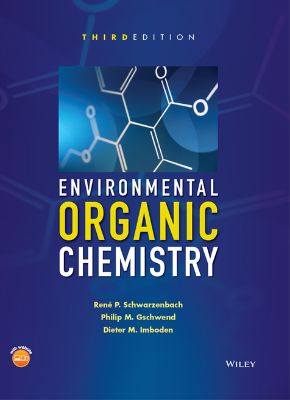Environmental Organic Chemistry
10.390 kr.

Lýsing:
Examines in a pedagogical way all pertinent molecular and macroscopic processes that govern the distribution and fate of organic chemicals in the environment and provides simple modeling tools to quantitatively describe these processes and their interplay in a given environmental system Treats fundamental aspects of chemistry, physics, and mathematical modeling as applied to environmentally relevant problems, and gives a state of the art account of the field Teaches the reader how to relate the structure of a given chemical to its physical chemical properties and intrinsic reactivities Provides a holistic and teachable treatment of phase partitioning and transformation processes, as well as a more focused and tailor-made presentation of physical, mathematical, and modeling aspects that apply to environmental situations of concern Includes a large number of questions and problems allowing teachers to explore the depth of understanding of their students or allowing individuals who use the book for self-study to check their progress Provides a companion website, which includes solutions for all problems as well as a large compilation of physical constants and compound propertiesAnnað
- Höfundar: René P. Schwarzenbach, Philip M. Gschwend, Dieter M. Imboden
- Útgáfa:3
- Útgáfudagur: 2016-10-12
- Hægt að prenta út 10 bls.
- Hægt að afrita 2 bls.
- Format:ePub
- ISBN 13: 9781118767047
- Print ISBN: 9781118767238
- ISBN 10: 1118767047
Efnisyfirlit
- Preface
- About the Companion Website
- Chapter 1 General Topic and Overview
- 1.1 Introduction
- 1.2 Assessing Organic Chemicals in the Environment
- 1.3 What is This Book All About?
- 1.4 Bibliography
- Part I Background Knowledge
- Chapter 2 Background Knowledge on Organic Chemicals
- 2.1 The Makeup of Organic Compounds
- 2.2 Intermolecular Forces Between Uncharged Molecules
- 2.3 Questions and Problems
- 2.4 Bibliography
- Chapter 3 The Amazing World of Anthropogenic Organic Chemicals
- 3.1 Introduction
- 3.2 A Lasting Global Problem: Persistent Organic Pollutants (POPs)
- 3.3 Natural but Nevertheless Problematic: Petroleum Hydrocarbons
- 3.4 Notorious Air and Groundwater Pollutants: Organic Solvents
- 3.5 Safety First: Flame Retardants All Around Us
- 3.6 How to Make Materials “Repellent”: Polyfluorinated Chemicals (PFCs)
- 3.7 From Washing Machines to Surface Waters: Complexing Agents, Surfactants, Whitening Agents, and Corrosion Inhibitors
- 3.8 Health, Well-Being, and Water Pollution: Pharmaceuticals and Personal Care Products
- 3.9 Fighting Pests: Herbicides, Insecticides, and Fungicides
- 3.10 Our Companion Compounds: Representative Model Chemicals
- 3.11 Questions
- 3.12 Bibliography
- Chapter 4 Background Thermodynamics, Equilibrium Partitioning and Acidity Constants
- 4.1 Important Thermodynamic Functions
- 4.2 Using Thermodynamic Functions to Quantify Equilibrium Partitioning
- 4.3 Organic Acids and Bases I: Acidity Constant and Speciation in Natural Waters
- 4.4 Organic Acids and Bases II: Chemical Structure and Acidity Constant
- 4.5 Questions and Problems
- 4.6 Bibliography
- Chapter 5 Earth Systems and Compartments
- 5.1 Introduction
- 5.2 The Atmosphere
- 5.3 Surface Waters and Sediments
- 5.4 Soil and Groundwater
- 5.5 Biota
- 5.5 Questions
- 5.7 Bibliography
- Chapter 6 Environmental Systems: Physical Processes and Mathematical Modeling
- 6.1 Systems and Models
- 6.2 Box Models: A Concept for a Simple World
- 6.3 When Space Matters: Transport Processes
- 6.4 Models in Space and Time
- 6.5 Questions and Problems
- 6.6 Bibliography
- Chapter 2 Background Knowledge on Organic Chemicals
- Chapter 7 Partitioning Between Bulk Phases: General Aspects and Modeling Approaches
- 7.1 Introduction
- 7.2 Molecular Interactions Governing Bulk Phase Partitioning of Organic Chemicals
- 7.3 Quantitative Approaches to Estimate Bulk Phase Partition Constants/Coefficients: Linear Free Energy Relationships (LFERs)
- 7.4 Questions
- 7.5 Bibliography
- Chapter 8 Vapor Pressure (pi*)
- 8.1 Introduction and Theoretical Background
- 8.2 Molecular Interactions Governing Vapor Pressure and Vapor Pressure Estimation Methods
- 8.3 Questions and Problems
- 8.4 Bibliography
- Chapter 9 Solubility (Csatiw) and Activity Coefficient (γsatiw)in Water; Air–Water Partition Constant (Kiaw)
- 9.1 Introduction and Thermodynamic Considerations
- 9.2 Molecular Interactions Governing the Aqueous Activity Coefficient and the Air–Water Partition Constant
- 9.3 LFERs for Estimating Air–Water Partition Constants and Aqueous Activity Coefficients/Aqueous Solubilities
- 9.4 Effect of Temperature, Dissolved Salts, and pH on the Aqueous Activity Coefficient/Aqueous Solubility and on the Air–Water Partition Constant
- 9.5 Questions and Problems
- 9.6 Bibliography
- Chapter 10 Organic Liquid–Air and Organic Liquid–Water Partitioning
- 10.1 Introduction
- 10.2 Thermodynamic Considerations and Comparisons of Different Organic Solvents
- 10.3 The Octanol–Water System: The Atom/Fragment Contribution Method for Estimation of the Octanol–Water Partition Constant
- 10.4 Partitioning Involving Organic Solvent–Water Mixtures
- 10.5 Evaporation and Dissolution of Organic Compounds from Organic Liquid Mixtures–Equilibrium Considerations
- 10.6 Questions and Problems
- 10.7 Bibliography
- Chapter 11 Partitioning of Nonionic Organic Compounds Between well-Defined Surfaces and Air Or Water
- 11.1 Introduction
- 11.2 Adsorption from Air to Well-Defined Surfaces
- 11.3 Adsorption from Water to Inorganic Surfaces
- 11.4 Questions and Problems
- 11.5 Bibliography
- Chapter 12 General Introduction to Sorption Processes
- 12.1 Introduction
- 12.2 Sorption Isotherms and the Solid–Water Equilibrium Distribution Coefficient (Kid)
- 12.3 Speciation (Sorbed versus Dissolved or Gaseous), Retardation, and Sedimentation
- 12.4 Questions and Problems
- 12.5 Bibliography
- Chapter 13 Sorption from Water to Natural Organic Matter (NOM)
- 13.1 The Structural Diversity of Natural Organic Matter Present in Aquatic and Terrestrial Environments
- 13.2 Quantifying Natural Organic Matter–Water Partitioning of Neutral Organic Compounds
- 13.3 Sorption of Organic Acids and Bases to Natural Organic Matter
- 13.4 Questions and Problems
- 13.5 Bibliography
- Chapter 14 Sorption of Ionic Organic Compounds to Charged Surfaces
- 14.1 Introduction
- 14.2 Cation and Anion Exchange Capacities of Solids in Water
- 14.3 Ion Exchange: Nonspecific Adsorption of Ionized Organic Chemicals from Aqueous Solutions to Charged Surfaces
- 14.4 Surface Complexation: Specific Bonding of Organic Compounds with Solid Phases in Water
- 14.5 Questions and Problems
- 14.6 Bibliography
- Chapter 15 Aerosol–Air Partitioning: Dry and Wet Deposition of Organic Pollutants
- 15.1 Origins and Properties of Atmospheric Aerosols
- 15.2 Assessing Aerosol–Air Partition Coefficients (KiPMa)
- 15.3 Dry and Wet Deposition
- 15.4 Questions and Problems
- 15.5 Bibliography
- Chapter 16 Equilibrium Partitioning from Water and Air to Biota
- 16.1 Introduction
- 16.2 Predicting Biota–Water and Biota–Air Equilibrium Partitioning
- 16.3 Bioaccumulation and Biomagnification in Aquatic Systems
- 16.4 Bioaccumulation and Biomagnification in Terrestrial Systems
- 16.5 Baseline Toxicity (Narcosis)
- 16.6 Questions and Problems
- 16.7 Bibliography
- Chapter 17 Random Motion, Molecular and Turbulent Diffusivity
- 17.1 Random Motion
- 17.2 Molecular Diffusion
- 17.3 Other Random Transport Processes in the Environment
- 17.4 Questions and Problems
- 17.5 Bibliography
- Chapter 18 Transport at Boundaries
- 18.1 The Role of Boundaries in the Environment
- 18.2 Bottleneck Boundaries
- 18.3 Wall Boundaries
- 18.4 Hybrid Boundaries
- 18.5 Questions and Problems
- 18.6 Bibliography
- Chapter 19 Air–Water Exchange
- 19.1 The Air–Water Interface
- 19.2 Air–Water Exchange Models
- 19.3 Measurement of Air–Water Exchange Velocities
- 19.4 Air–Water Exchange in Flowing Waters
- 19.5 Questions and Problems
- 19.6 Bibliography
- Chapter 20 Interfaces Involving Solids
- 20.1 The Sediment–Water Interface
- 20.2 Transport in Unsaturated Soil
- 20.3 Questions and Problems
- 20.4 Bibliography
- Chapter 21 Background Knowledge on Transformation Reactions of Organic Pollutants
- 21.1 Identifying Reactive Sites Within Organic Molecules
- 21.2 Thermodynamics of Transformation Reactions
- 21.3 Kinetics of Transformation Reactions
- 21.4 Questions and Problems
- 21.5 Bibliography
- Chapter 22 Hydrolysis and Reactions with Other Nucleophiles
- 22.1 Nucleophilic Substitution and Elimination Reactions Involving Primarily Saturated Carbon Atoms
- 22.2 Hydrolytic Reactions of Carboxylic and Carbonic Acid Derivatives
- 22.3 Enzyme-Catalyzed Hydrolysis Reactions: Hydrolases
- 22.4 Questions and Problems
- 22.5 Bibliography
- Chapter 23 Redox Reactions
- 23.1 Introduction
- 23.2 Evaluating the Thermodynamics of Redox Reactions
- 23.3 Examples of Chemical Redox Reactions in Natural Systems
- 23.4 Examples of Enzyme-Catalyzed Redox Reactions
- 23.5 Questions and Problems
- 23.6 Bibliography
- Chapter 24 Direct Photolysis in Aquatic Systems
- 24.1 Introduction
- 24.2 Some Basic Principles of Photochemistry
- 24.3 Light Absorption by Organic Compounds in Natural Waters
- 24.4 Quantum Yield and Rate of Direct Photolysis
- 24.5 Effects of Solid Sorbents (Particles, Soil Surfaces, Ice) on Direct Photolysis
- 24.6 Questions and Problems
- 24.7 Bibliography
- Chapter 25 Indirect Photolysis: Reactions with Photooxidants in Natural Waters and in the Atmosphere
- 25.1 Introduction
- 25.2 Indirect Photolysis in Surface Waters
- 25.3 Indirect Photolysis in the Atmosphere (Troposphere): Reaction with Hydroxyl Radical (HO•)
- 25.4 Questions and Problems
- 25.6 Bibliography
- Chapter 26 Biotransformations
- 26.1 Introduction
- 26.2 Some Important Concepts about Microorganisms Relevant to Biotransformations
- 26.3 Initial Biotransformation Strategies
- 26.4 Rates of Biotransformations
- 26.5 Questions and Problems
- 26.6 Bibliography
- Chapter 27 Assessing Transformation Processes Using Compound-Specific Isotope Analysis (CSIA)
- 27.1 Introduction, Methodology, and Theoretical Background
- 27.2 Using CSIA for Assessing Organic Compound Transformations in Laboratory and Field Systems
- 27.3 Questions and Problems
- 27.4 Bibliography
- Chapter 28 Exposure Assessment of Organic Pollutants Using Simple Modeling Approaches
- 28.1 One-Box Model: The Universal Tool for Process Integration
- 28.2 Assessing Equilibrium Partitioning in Simple Multimedia Systems
- 28.3 Simple Dynamic Systems
- 28.4 Systems Driven by Advection
- 28.5 Bibliography
UM RAFBÆKUR Á HEIMKAUP.IS
Bókahillan þín er þitt svæði og þar eru bækurnar þínar geymdar. Þú kemst í bókahilluna þína hvar og hvenær sem er í tölvu eða snjalltæki. Einfalt og þægilegt!Rafbók til eignar
Rafbók til eignar þarf að hlaða niður á þau tæki sem þú vilt nota innan eins árs frá því bókin er keypt.
Þú kemst í bækurnar hvar sem er
Þú getur nálgast allar raf(skóla)bækurnar þínar á einu augabragði, hvar og hvenær sem er í bókahillunni þinni. Engin taska, enginn kyndill og ekkert vesen (hvað þá yfirvigt).
Auðvelt að fletta og leita
Þú getur flakkað milli síðna og kafla eins og þér hentar best og farið beint í ákveðna kafla úr efnisyfirlitinu. Í leitinni finnur þú orð, kafla eða síður í einum smelli.
Glósur og yfirstrikanir
Þú getur auðkennt textabrot með mismunandi litum og skrifað glósur að vild í rafbókina. Þú getur jafnvel séð glósur og yfirstrikanir hjá bekkjarsystkinum og kennara ef þeir leyfa það. Allt á einum stað.
Hvað viltu sjá? / Þú ræður hvernig síðan lítur út
Þú lagar síðuna að þínum þörfum. Stækkaðu eða minnkaðu myndir og texta með multi-level zoom til að sjá síðuna eins og þér hentar best í þínu námi.
Fleiri góðir kostir
- Þú getur prentað síður úr bókinni (innan þeirra marka sem útgefandinn setur)
- Möguleiki á tengingu við annað stafrænt og gagnvirkt efni, svo sem myndbönd eða spurningar úr efninu
- Auðvelt að afrita og líma efni/texta fyrir t.d. heimaverkefni eða ritgerðir
- Styður tækni sem hjálpar nemendum með sjón- eða heyrnarskerðingu
- Gerð : 208
- Höfundur : 12087
- Útgáfuár : 2016
- Leyfi : 380


